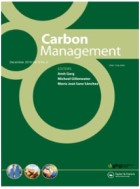Globally, belowground biomass (BGB) accounts for 20–26% of total biomass, and as such it is an important carbon (C) pool for many vegetation types. However, large uncertainty exists for belowground biomass C compared to aboveground stocks. Using data from 108 destructively harvested trees belonging to 36 miombo species, we estimated root to shoot ratios, and developed models for estimation of aboveground biomass (AGB), BGB and total biomass C stocks in the Copperbelt province of Zambia. We also validated our models using independent datasets from elsewhere in Zambia and Malawi. The C fractions in wood ranged between 51.9 and 58.9%, which was higher than the IPCC default value. The root to shoot ratio was found to be 0.303. The analysis also demonstrated isometric scaling of BGB with AGB. According to cross-validation results, the model that incorporated wood density (ρ), diameter at breast height (D) and total stem height (H) formulated as AGB =0.093(ρD2H)0.97 *1.08 outperformed existing models developed for the miombo woodlands in Zambia. The best model for BGB was BGB = 0.476(AGB)0.88*1.126. Using the top-ranked models, the stand-level AGB stocks were estimated at 222.2 Mg ha−1, while BGB stocks were estimated at 52.4 Mg ha−1. Aboveground and belowground C stocks were 125.3 Mg ha−1 and 29.5 Mg ha−1, respectively. Total biomass C stocks were estimated at 152.1 Mg ha−1 or 558.3 Mg ha−1 CO2 equivalent sequestered in tree biomass. These estimates may be used as baseline data for future carbon management and for emerging payment for ecosystem services projects in miombo woodlands.

